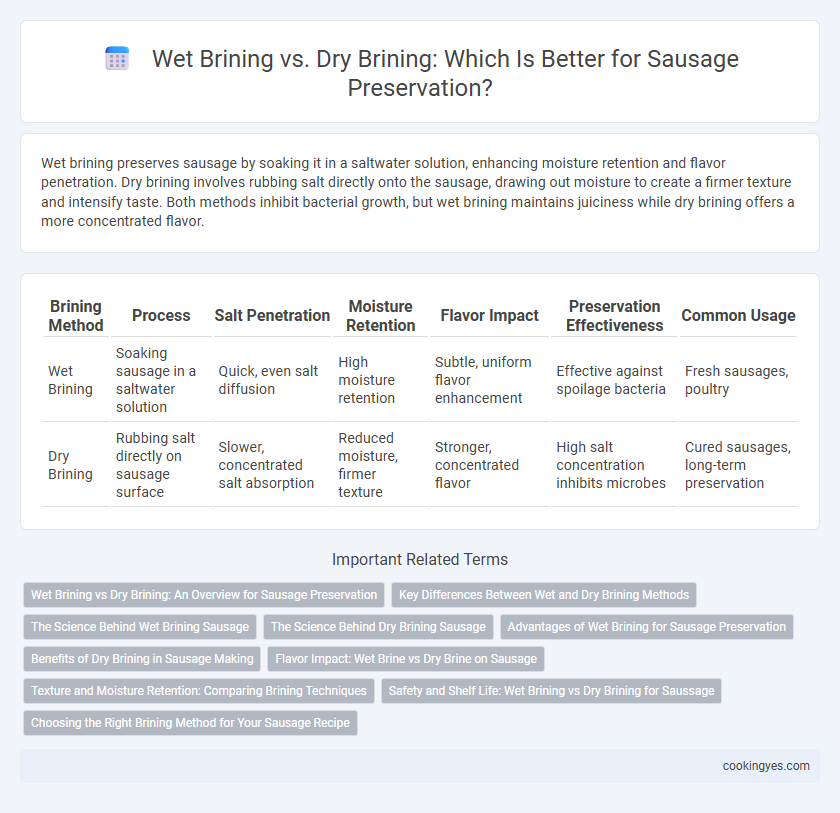Wet brining preserves sausage by soaking it in a saltwater solution, enhancing moisture retention and flavor penetration. Dry brining involves rubbing salt directly onto the sausage, drawing out moisture to create a firmer texture and intensify taste. Both methods inhibit bacterial growth, but wet brining maintains juiciness while dry brining offers a more concentrated flavor.
Table of Comparison
| Brining Method | Process | Salt Penetration | Moisture Retention | Flavor Impact | Preservation Effectiveness | Common Usage |
|---|---|---|---|---|---|---|
| Wet Brining | Soaking sausage in a saltwater solution | Quick, even salt diffusion | High moisture retention | Subtle, uniform flavor enhancement | Effective against spoilage bacteria | Fresh sausages, poultry |
| Dry Brining | Rubbing salt directly on sausage surface | Slower, concentrated salt absorption | Reduced moisture, firmer texture | Stronger, concentrated flavor | High salt concentration inhibits microbes | Cured sausages, long-term preservation |
Wet Brining vs Dry Brining: An Overview for Sausage Preservation
Wet brining delivers moisture and salt directly into sausage, enhancing juiciness and flavor retention during preservation. Dry brining uses salt and spices applied externally, drawing out moisture to inhibit bacterial growth and concentrate flavors. Both methods extend sausage shelf life but differ in texture impact and salt absorption efficiency.
Key Differences Between Wet and Dry Brining Methods
Wet brining involves soaking sausages in a saltwater solution, enhancing moisture retention and flavor penetration through osmosis, while dry brining uses only salt and seasonings directly applied to the meat, promoting a firmer texture by drawing out surface moisture. Wet brining typically requires refrigeration and longer processing times to achieve preservation, whereas dry brining is faster and less labor-intensive, often favored for its simplicity and creating a more concentrated taste. Both methods are effective for preservation, but wet brining excels in juiciness, and dry brining enhances texture and flavor intensity.
The Science Behind Wet Brining Sausage
Wet brining sausage involves immersing the meat in a saline solution that enhances water retention and protein extraction, leading to improved texture and juiciness. The salt in the solution denatures muscle proteins, enabling them to bind water more effectively, which prevents moisture loss during cooking and extends shelf life. This method also inhibits bacterial growth by lowering water activity, making it a scientifically effective preservation technique.
The Science Behind Dry Brining Sausage
Dry brining sausage involves applying salt directly to the meat, which draws out moisture through osmosis and then allows it to be reabsorbed, enhancing flavor and texture. This process promotes protein denaturation and binds water efficiently, resulting in a firmer, juicier sausage with improved preservation qualities. Compared to wet brining, dry brining reduces microbial growth by lowering water activity, thereby extending the sausage's shelf life naturally.
Advantages of Wet Brining for Sausage Preservation
Wet brining enhances sausage preservation by promoting even salt distribution, which improves moisture retention and texture. The immersion in a flavorful solution facilitates better penetration of curing agents, resulting in superior taste and extended shelf life. This method also reduces the risk of bacterial growth by maintaining a consistent brine concentration throughout the sausage.
Benefits of Dry Brining in Sausage Making
Dry brining in sausage making enhances flavor penetration by allowing salt to directly draw out moisture, intensifying seasoning without diluting the meat. It improves texture by breaking down muscle proteins, leading to a firmer, more cohesive sausage. This method also extends shelf life through moisture reduction, inhibiting bacterial growth while preserving the sausage's natural juiciness.
Flavor Impact: Wet Brine vs Dry Brine on Sausage
Wet brining infuses sausages with a pronounced, juicy flavor by allowing the salt and aromatic liquids to penetrate deeply, enhancing moisture retention and tenderness. Dry brining intensifies the natural meat taste by drawing out moisture and concentrating flavors, resulting in a firmer texture with a more robust, seasoned profile. Both methods impact sausage preservation by balancing salt concentration and moisture, but wet brine typically yields a milder, sweeter flavor while dry brine offers a stronger, saltier bite.
Texture and Moisture Retention: Comparing Brining Techniques
Wet brining saturates sausage meat by soaking it in a saltwater solution, enhancing moisture retention and producing a juicier texture. Dry brining, which involves rubbing salt and seasonings directly onto the meat, intensifies flavor while drawing out some moisture, resulting in a firmer, denser texture. Texture and moisture retention vary significantly between these methods, with wet brining offering a softer bite and dry brining creating a compact, flavorful sausage.
Safety and Shelf Life: Wet Brining vs Dry Brining for Saussage
Wet brining sausages involves immersing them in a saltwater solution, which enhances moisture retention but can increase microbial growth risk if not properly refrigerated, potentially shortening shelf life. Dry brining uses salt directly applied to the sausage surface, drawing out moisture and creating an environment less conducive to bacterial growth, thus improving safety and extending shelf life. Proper temperature control and salt concentration in both methods are critical factors influencing the preservation efficiency and safety of sausages.
Choosing the Right Brining Method for Your Sausage Recipe
Wet brining involves soaking sausages in a saltwater solution, enhancing moisture retention and flavor infusion, making it ideal for recipes requiring juicier texture. Dry brining uses coarse salt applied directly to the sausage, drawing out moisture and intensifying savory taste while improving preservation through reduced surface moisture. Selecting the appropriate brining method depends on desired sausage texture, flavor profile, and shelf life considerations.
Wet brining vs dry brining for preservation Infographic

 cookingyes.com
cookingyes.com